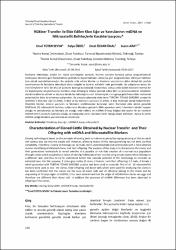| dc.contributor.author | Sevim, Emel Tüten | |
| dc.contributor.author | Özdil, Fulya | |
| dc.contributor.author | Ünal, Emel Özkan | |
| dc.contributor.author | Arat, Sezen | |
| dc.date.accessioned | 2017-07-31T07:42:48Z | |
| dc.date.available | 2017-07-31T07:42:48Z | |
| dc.date.issued | 2017 | |
| dc.identifier.uri | https://hdl.handle.net/20.500.11776/2160 | |
| dc.description.abstract | Klonlama teknolojisi; erişkin bir hücre çekirdeğinin yumurta hücresi içerisine konulup geriye programlanarak embriyonal döneme geri döndürülmesi prensibine dayanmaktadır. Ancak bu geri programlamayı etkileyen faktörler tam olarak aydınlatılamamıştır. Bu nedenle elde edilen klonlar ve klonların yavrularının daha detaylı bir şekilde tanımlanması ile klonlama teknolojisi daha anlaşılır ve kontrol edilebilir hale getirilebilir. Bu çalışmanın amacı bir ırkın bireylerinin farklı bir ırka ait yumurta kaynağı kullanılarak klonlanması sonucu elde edilen klonların normal bir ırk populasyonu oluşturmasının mümkün olup olmadığını ortaya koymak adına klon ve jenerasyonlarını moleküler olarak karakterize etmek ve böylece ileride bu teknolojinin nesli tükenmiş bir ırkın geriye getirilmesindeki muhtemel potansiyelini daha iyi anlamaya çalışmaktır. Bu amaçla çalışmada daha önce TÜBİTAK- TOVAG-104O360- projesi ile üretilmiş 5 klon boz sığır (1 erkek, 4 dişi) ve bu klonların yavruları (2 erkek, 4 dişi) materyal olarak kullanılmıştır. Öncelikle klonlar, onların yavruları ve klonların üretilmesinde kullanılan verici hücreden elde edilen genomik DNA’larda 10 mikrosatellit belirteç kullanılarak klonların genomik DNA açısından verici hücrelerin birebir kopyası olduğu ve yavrularında bu klonlara ait olduğu teyit edilmiş ve mtDNA D-loop bölgesi dizi analizi ile de klonların mtDNA’larının yumurta kaynaklı olduğu ve dolayısıyla verici hücreden farklı olduğu tespit edilmiştir. Ayrıca bu farklı mtDNA varlığı klonların yavrularında da izlenmiştir. | en_US |
| dc.description.abstract | Cloning technology is based on the principle of turning back to embryonic period by reprogramming of that an adult cell nucleus was put into the oocyte cell. However, affecting factors of this reprogramming has not been clarified completely. Therefore, cloning technology can be made more understandable and controllable with a more detailed manner identifying of obtained clones and their offspring. The purpose of the study is to characterize the clones and their generations molecularly to reveal whether it is possible or not that creation of a normal race population through clones which acquired as a result of cloning individuals of one race by using ovular source which belongs to a different race, and thus to try to understand better that possible potential of this technology to reinstate an extincted race. For this purpose, 5 clone grey cattles (1 male, 4 female ) and their offsprings ( 2 male, 4 female ) which generated with TUBİTAK TOVAG-104O360- project had been used as material. First of all 10 microsatellite markers were used to test the clones, their offspring and donor cells which were used for producing the clones.It has been confirmed that the clones are the copy of donor cells and all offspring belong to the clones and by sequencing of D-Loop region of mtDNA, it has been determined that the origin of mtDNA from clones are eggs and therefore are different than donor cell. In addition the presence of mtDNA difference has been observed in offspring of the clones. | en_US |
| dc.language.iso | tur | en_US |
| dc.publisher | Namık Kemal Üniversitesi, Ziraat Fakültesi | en_US |
| dc.rights | info:eu-repo/semantics/openAccess | en_US |
| dc.subject | Klonlama | en_US |
| dc.subject | boz sığır | en_US |
| dc.subject | mtDNA D-Loop | en_US |
| dc.subject | mikrosatellit | en_US |
| dc.subject | Cloning | en_US |
| dc.subject | Grey Cattle | en_US |
| dc.subject | microsatellite | en_US |
| dc.title | Nükleer Transfer ile Elde Edilen Klon Sığır ve Yavrularının mtDNA ve Mikrosatellit Belirteçlerle Karakterizasyonu | en_US |
| dc.title.alternative | Characterization of Cloned Cattle Obtained by Nuclear Transfer and Their Offspring with mtDNA and Microsatellite Markers | en_US |
| dc.type | article | en_US |
| dc.relation.ispartof | Tekirdağ Ziraat Fakültesi Dergisi | en_US |
| dc.department | Fakülteler, Ziraat Fakültesi, Tarımsal Biyoteknoloji Bölümü | en_US |
| dc.authorid | 104781 | en_US |
| dc.authorid | 102866 | en_US |
| dc.authorid | 114114 | en_US |
| dc.identifier.volume | 14 | en_US |
| dc.identifier.issue | 2 | en_US |
| dc.identifier.startpage | 150 | en_US |
| dc.identifier.endpage | 157 | en_US |
| dc.relation.publicationcategory | Makale - Ulusal Hakemli Dergi - Kurum Öğretim Elemanı | en_US |



















